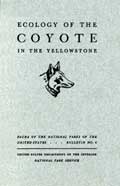.gif)
MENU
![]() Introduction
Introduction
|
Fauna of the National Parks — No. 4
Ecology of the Coyote in the Yellowstone |

|
CHAPTER I:
INTRODUCTION

(click on map for an enlargement in a new
window)
LOCATION AND GENERAL CHARACTER OF AREA
YELLOWSTONE National Park lies in northwestern Wyoming and takes in narrow strips of Montana and Idaho. It embraces about 3,500 square miles of mountainous and plateau country, volcanic in origin. Yellowstone Lake, near the center of the park, is surrounded by broken and rolling country sometimes called the central plateau, having an average altitude of 8,000 feet above sea level. This central plateau is bordered by mountain ranges reaching an altitude of about 10,000 feet. The north side of the park is lower, varying from about 5,300 feet near Gardiner to 6,500 feet at the Buffalo Ranch on the Lamar River. This area, along the Yellowstone and Lamar Rivers, receives less snowfall than the more elevated interior and constitutes the main winter big game range in the park. A large part of the park is covered with lodgepole pine, but Douglas fir and spruce are common species, and whitebark pine is found at high altitudes. Open grassland is common on the high slopes and throughout the low northern area, interspersed with sagebrush in the latter locality. Small meadows occur abundantly all over the park. The Upper Sonoran Zone reaches into the park at Gardiner. Most of the park is in the Canadian Zone and the Hudsonian and Arctic-Alpine Zones are also represented. The general character of the flora and fauna of Yellowstone National Park can be secured from Bailey (1930) and Skinner (1927).
North of Yellowstone National Park lies the Absaroka National Forest and the long open valley of the Yellowstone River; to the east is the rough wilderness of the Shoshone National Forest; to the south is the Teton National Forest and the Grand Teton National Park embracing the beautiful wild Jackson Hole country; to the west lies the Gallatin and Targhee National Forests. Yellowstone National Park is surrounded by a number of wilderness areas, a fact which is important in the preservation of rare carnivores within its boundaries.
Continued >>>
 Top
Top
Last Modified: Thurs, Dec 20 2001 10:00:00 pm PDT
http://www.cr.nps.gov/history/online_books/fauna4/fauna1.htm
![]()
